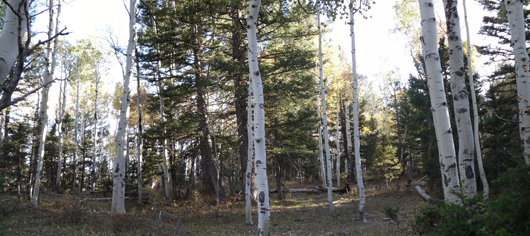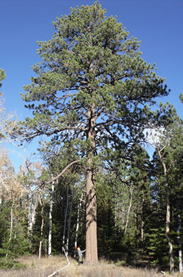USA: Ecology for the future in Colorado's forests
24.02.10
Colorado is a heavily forested, high-altitude state. Dan Binkley (Colorado State University) and Sally L. Duncan (Oregon State University) looked to the past to help understand the future of these forested landscapes in their recent study in Ecology and Society.

An aspen forest with mixed conifers (above) and an ancient Ponderosa pine (below left).
© Dan Binkley
 Colorado's native ecosystems span high-desert grassland steppes through riparian and wetland ecosystems up into coniferous forests and alpine tundra. This rich habitat mix naturally supports a wealth of biodiversity. The Colorado Natural Heritage Program tracks the status of more than 1,100 plant communities, which the report says, provides habitat for 18 species of amphibians, 48 reptiles, 123 mammals, and 408 birds. The state contains 11 of the USA's 155 National Forests, spread about 41 states, and the major forest types are Pinyon-Juniper woodland (6.1 million acres), Ponderosa pine (3.4), Mixed conifer-Douglas fir (1.5), Aspen (3.2), Lodgepole pine (2.2), Engelmann spruce-subalpine fir (4.7).
Colorado's native ecosystems span high-desert grassland steppes through riparian and wetland ecosystems up into coniferous forests and alpine tundra. This rich habitat mix naturally supports a wealth of biodiversity. The Colorado Natural Heritage Program tracks the status of more than 1,100 plant communities, which the report says, provides habitat for 18 species of amphibians, 48 reptiles, 123 mammals, and 408 birds. The state contains 11 of the USA's 155 National Forests, spread about 41 states, and the major forest types are Pinyon-Juniper woodland (6.1 million acres), Ponderosa pine (3.4), Mixed conifer-Douglas fir (1.5), Aspen (3.2), Lodgepole pine (2.2), Engelmann spruce-subalpine fir (4.7).
This diversity and scale of Colorado's forests mean they are extremely complex systems that have been shaped by a history of human use. European settlement of Colorado became substantial in the late 1700s and thus began the recent changing of the forested landscapes through the introduction of grazing, widespread mining, and timber-hungry railway development. The late 1800s saw a marked increase in forest fires, which was perhaps linked to the increase in human activity, but probably also tied to a slightly warmer and drier climate.
The fires have abated, due to a combination of human influence (creating fire-breaks and so on) and natural factors, but there are now new pressures on the landscape. In recent years a rapidly expanding population - up to 40% in some areas between 1990 and 2000 - has seen many traditionally rural areas being invaded by sprawling residential and holiday homes occupying large swathes of the landscape. This invasion has been fuelled by the fact most of the state's forests are within a couple of hours' drive of a million people.
As with many of the remote places on earth the motor car has reduced expansive wilderness to the status of a mere day trip.
So what of the future?
The Colorado landscape, its ecological history, biodiversity, and social context formed one of the regional case studies for the Future Range of Variability (FRV) project funded by the National Commission on Science and Sustainable Forestry. This combined a literature search of the historic ecological changes and a social assessment of planning for biodiversity conservation and future social and ecological trends.
As the authors point out, "traditionally ecological and social assessments have been designed and executed separately, with no acknowledgement that each is crucial to weaving a complete tapestry of a region's biodiversity status, potential, and challenges." Of course, the reality is very different. "Ecological and social contexts are co-dependent and even co-created: unless we pretend that human beings and their daily pursuits don't exist, how they treat their ecosystems and what they think they know about them are inextricably connected," the authors continue.
It is in the understanding of this complicated marriage where the future of Colorado's forests lies; it asks people to define and re-develop active physical and mental connections with their shared landscapes. In the face of urban sprawl, road-building, tourism, and all other human impacts it should help policy-makers, communities, and conservationists work together to shape and protect these forested lands.
Read the full article in Ecology and Society
Related links:
Colorado, USA: Plant Conservation Initiative and "The Forgotten Majority"
17.08.09
![]() A new conservation partnership in Colorado aims to protect endemic species in the state well into the next decade.
A new conservation partnership in Colorado aims to protect endemic species in the state well into the next decade.